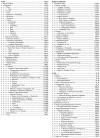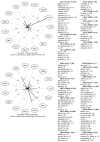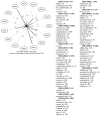Exploring semantic groups through visual approaches
- PMID: 14759816
- PMCID: PMC1997308
- DOI: 10.1016/j.jbi.2003.11.002
Exploring semantic groups through visual approaches
Abstract
Objectives. We investigate several visual approaches for exploring semantic groups, a grouping of semantic types from the Unified Medical Language System (UMLS) semantic network. We are particularly interested in the semantic coherence of the groups, and we use the semantic relationships as important indicators of that coherence. Methods. First, we create a radial representation of the number of relationships among the groups, generating a profile for each semantic group. Second, we show that, in our partition, the relationships are organized around a limited number of pivot groups and that partitions created at random do not exhibit this property. Finally, we use correspondence analysis to visualize groupings resulting from the association between semantic types and the relationships. Results. The three approaches provide different views on the semantic groups and help detect potential inconsistencies. They make outliers immediately apparent, and, thus, serve as a tool for auditing and validating both the semantic network and the semantic groups.
Figures






Similar articles
-
Consistency across the hierarchies of the UMLS Semantic Network and Metathesaurus.J Biomed Inform. 2003 Dec;36(6):450-61. doi: 10.1016/j.jbi.2003.11.001. J Biomed Inform. 2003. PMID: 14759818
-
Designing metaschemas for the UMLS enriched semantic network.J Biomed Inform. 2003 Dec;36(6):433-49. doi: 10.1016/j.jbi.2003.11.006. J Biomed Inform. 2003. PMID: 14759817
-
The interaction of domain knowledge and linguistic structure in natural language processing: interpreting hypernymic propositions in biomedical text.J Biomed Inform. 2003 Dec;36(6):462-77. doi: 10.1016/j.jbi.2003.11.003. J Biomed Inform. 2003. PMID: 14759819
-
Information retrieval and knowledge discovery utilising a biomedical Semantic Web.Brief Bioinform. 2005 Sep;6(3):252-62. doi: 10.1093/bib/6.3.252. Brief Bioinform. 2005. PMID: 16212773 Review.
-
Towards Semantic e-Science for Traditional Chinese Medicine.BMC Bioinformatics. 2007 May 9;8 Suppl 3(Suppl 3):S6. doi: 10.1186/1471-2105-8-S3-S6. BMC Bioinformatics. 2007. PMID: 17493289 Free PMC article. Review.
Cited by
-
A chemical specialty semantic network for the Unified Medical Language System.J Cheminform. 2012 May 11;4(1):9. doi: 10.1186/1758-2946-4-9. J Cheminform. 2012. PMID: 22577759 Free PMC article.
-
A multilingual gold-standard corpus for biomedical concept recognition: the Mantra GSC.J Am Med Inform Assoc. 2015 Sep;22(5):948-56. doi: 10.1093/jamia/ocv037. Epub 2015 May 6. J Am Med Inform Assoc. 2015. PMID: 25948699 Free PMC article.
-
Towards comprehensive syntactic and semantic annotations of the clinical narrative.J Am Med Inform Assoc. 2013 Sep-Oct;20(5):922-30. doi: 10.1136/amiajnl-2012-001317. Epub 2013 Jan 25. J Am Med Inform Assoc. 2013. PMID: 23355458 Free PMC article.
-
Relationship structures and semantic type assignments of the UMLS Enriched Semantic Network.J Am Med Inform Assoc. 2005 Nov-Dec;12(6):657-66. doi: 10.1197/jamia.M1605. Epub 2005 Jul 27. J Am Med Inform Assoc. 2005. PMID: 16049233 Free PMC article.
-
Building and evaluating annotated corpora for medical NLP systems.AMIA Annu Symp Proc. 2006;2006:1050. AMIA Annu Symp Proc. 2006. PMID: 17238668 Free PMC article.
References
-
- McCray AT. The scope and structure of the first version of the UMLS Semantic Network. Proc Annu Symp Comput Appl Med Care. 1990:126–30.
-
- Chen Z, Perl Y, Halper M, Geller J, Gu H. Partitioning the UMLS semantic network. IEEE Trans Inf Technol Biomed. 2002;6(2):102–8. - PubMed
-
- Nelson SJ, Sheretz DD, Tuttle MS, Erlbaum MS. Using Meta-Card: a HyperCard browser for biomedical knowledge sources. Proc Annu Symp Comput Appl Med Care. 1990:151–4.
-
- Rindflesch TC, Fiszman M. The interaction of domain knowledge and linguistic structure in natural language processing: interpreting hypernymic propositions in biomedical text. J Biomed Inform. 2003;36:462–77. - PubMed
Publication types
MeSH terms
Grants and funding
LinkOut - more resources
Full Text Sources
Other Literature Sources

